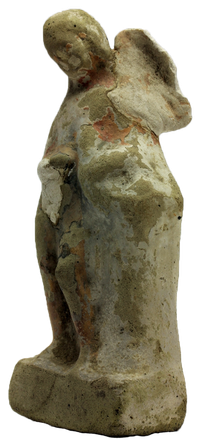Eros with goose
Description: A winged boy leaning against a pillar and holding a long-necked bird in his left arm stands on a low cuboid base. The right leg is stretched, the left slightly bent at the hips and knees, a little forward and splayed. The genitals are visible below the pubic mound. Between the left leg and the pillar thin folds of the robe can be seen. The right arm lies in front of the body with the elbow bent; the left rests with the forearm on the pillar while the hand grasps the stretched neck of the animal.
The boy's head leans decidedly to the right, turning slightly to the left. Close-fitting, chin-length hair is braided into a little plait on the crown of the head. In the rounded oval of the face, the cheeks are vividly emphasised.
Commentary: The childlike Eros with goose leaning against a pillar is well attested in Campania. Apart from Capua[1], other examples have been recovered from a find complex in Teano (Teanum), among others[2].
Since the early 4th century BC, crown braids have been part of the representation of infantile hair costumes in Greece[3]. Other characteristics of the early child period, which can also be observed on the terracotta eros from Campania, are the relatively large heads, full bellies and rounded thighs. The combination of the Eros figure with the goose and the pillar is reminiscent of the marble statue from Lilaia[4], which, however, already differs from the latter in the stance motif with crossed legs and the slender, stretched thighs[5]. The spherical head with the chubby cheeks, also contrasts with the oval head of the Giessen Eros, whose contour line is more comparable to the head of the Lysippian Eros[6]. The smooth elongated cheeks spread more into the surface in the terracotta statuettes, which seems to limit the view to the front.
Two motifs are combined in the clay figurines, namely that of the naked boy leaning against a pillar holding (pressing) a long-necked bird[7] and that of the winged Eros. This combination is obviously centred in Campania, where the clay figurines were also conceived, probably between 340 and 310 BC[8].
Determination: End of the 4th century BC, from Campania (Capua, Teano/Teanum).
 |
 |
 |
[1] L. Melillo Faenza, Il santuario del fondo Patturelli, in: Il Museo Archeologico dell’Antica Capua (Neapel 1995) 62 f.; more parallels in Capua, Museo Campano, Wamser-Krasznai, ungedruckte Magisterarbeit Gießen 1996 , 62-70 fig. 2 pl. 38; Winter 2 1903, 284, 10; A. Scatozza Höricht, Le terrecotte figurate di Cuma del Museo Archeologico Nazionale di Napoli (Rom 1987) 86 pl. 17 b; from the surroundings of Taranto: heavily damaged Eros with the same shape and posture of the head in an inverted stance motif, M. R. Palumbo, Le terrecotte figurate di Tipo Greco in Daunia, Peukezia e Messapia (Galatina/Lecce 1986) 109 no. 540 pl. 26.
[2] Net lekyths, local black varnish pottery and Campanian coins with the head of Mars pointing to the beginning of the 3rd century BC, W. Johannowsky, Relazione preliminare sugli scavi di Teano, BdA 1963, 148. 151 fig. 14 m.
[3] Chr. Vorster, Griechische Kinderstatuen (Köln 1983) 218. A copy of the Lysippian Eros in Baltimore (head) is said to have come from Capua, E. D. Reeder, Hellenistic Art in the Walters Art Gallery (Princeton 1988), 78, no. 7; P. Moreno (Hrsg.), Lisippo. L’arte e la fortuna (Monza 1995), 118-121 fig. 4.15.V
[4] Athen, NM, Inv. 2772, H. Rühfel, Das Kind in der griechischen Kunst (Mainz 1984), 227 f. no. 95 p. 241.
[5] For the stance motif see Vorster 1983, 161 f. 349 note 172.
[6] Lisippo. L’arte e la fortuna (Monza 1995), 118-121 fig. 4.15.V.
[7] H. Rühfel restricts himself to the designation „Spieltier“ or „Spielvogel“, dies. ibid. 227. 230.
[8] Vorster 1983, 161 f.

